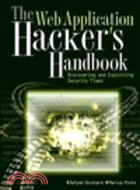| FindBook |
有 1 項符合
THE WEB APPLICATION HACKER'S HANDBOOK的圖書 |
 |
THE WEB APPLICATION HACKER'S HANDBOOK 作者:STUTTARD 出版社:JOHN WILEY & SONS,LTD 出版日期:2007-01-01 |
| 圖書館借閱 |
| 國家圖書館 | 全國圖書書目資訊網 | 國立公共資訊圖書館 | 電子書服務平台 | MetaCat 跨館整合查詢 |
| 臺北市立圖書館 | 新北市立圖書館 | 基隆市公共圖書館 | 桃園市立圖書館 | 新竹縣公共圖書館 |
| 苗栗縣立圖書館 | 臺中市立圖書館 | 彰化縣公共圖書館 | 南投縣文化局 | 雲林縣公共圖書館 |
| 嘉義縣圖書館 | 臺南市立圖書館 | 高雄市立圖書館 | 屏東縣公共圖書館 | 宜蘭縣公共圖書館 |
| 花蓮縣文化局 | 臺東縣文化處 |
|
|
- 圖書簡介
This book is a practical guide to discovering and exploiting security flaws in web applications. The authors explain each category of vulnerability using real-world examples, screen shots and code extracts. The book is extremely practical in focus, and describes in detail the steps involved in detecting and exploiting each kind of security weakness found within a variety of applications such as online banking, e-commerce and other web applications.
The topics covered include bypassing login mechanisms, injecting code, exploiting logic flaws and compromising other users. Because every web application is different, attacking them entails bringing to bear various general principles, techniques and experience in an imaginative way. The most successful hackers go beyond this, and find ways to automate their bespoke attacks. This handbook describes a proven methodology that combines the virtues of human intelligence and computerized brute force, often with devastating results.
The authors are professional penetration testers who have been involved in web application security for nearly a decade. They have presented training courses at the Black Hat security conferences throughout the world. Under the alias "PortSwigger", Dafydd developed the popular Burp Suite of web application hack tools. - 作者簡介
Dafydd Stuttard is a Principal Security Consultant at Next Generation Security Software, where he leads the web application security competency. He has nine years' experience in security consulting and specializes in the penetration testing of web applications and compiled software. Dafydd has worked with numerous banks, retailers, and other enterprises to help secure their web applications, and has provided security consulting to several software manufacturers and governments to help secure their compiled software. Dafydd is an accomplished programmer in several languages, and his interests include developing tools to facilitate all kinds of software security testing. Dafydd has developed and presented training courses at the Black Hat security conferences around the world. Under the alias "PortSwigger," Dafydd created the popular Burp Suite of web application hacking tools. Dafydd holds master's and doctorate degrees in philosophy from the University of Oxford.
Marcus Pinto is a Principal Security Consultant at Next Generation Security Software, where he leads the database competency development team, and has lead the development of NGS' primary training courses. He has eight years' experience in security consulting and specializes in penetration testing of web applications and supporting architectures. Marcus has worked with numerous banks, retailers, and other enterprises to help secure their web applications, and has provided security consulting to the development projects of several security-critical applications. He has worked extensively with large-scale web application deployments in the financial services industry. Marcus has developed and presented database and web application training courses at the Black Hat and other security conferences around the world. Marcus holds a master's degree in physics from the University of Cambridge. - 名人/編輯推薦
"If you have an interest in web application security, I would highly recommend picking up a copy of this book, especially if you’re interested in being able to audit applications for vulnerabilities".
—Robert Wesley McGrew, McGrew Security - 目次
Acknowledgments.
Introduction.
Chapter 1 Web Application (In)security.
Chapter 2 Core Defense Mechanisms.
Chapter 3 Web Application Technologies.
Chapter 4 Mapping the Application.
Chapter 5 Bypassing Client-Side Controls.
Chapter 6 Attacking Authentication.
Chapter 7 Attacking Session Management.
Chapter 8 Attacking Access Controls.
Chapter 9 Injecting Code.
Chapter 10 Exploiting Path Traversal.
Chapter 11 Attacking Application Logic.
Chapter 12 Attacking Other Users.
Chapter 13 Automating Bespoke Attacks.
Chapter 14 Exploiting Information Disclosure.
Chapter 15 Attacking Compiled Applications.
Chapter 16 Attacking Application Architecture.
Chapter 17 Attacking the Web Server.
Chapter 18 Finding Vulnerabilities in Source Code.
Chapter 19 A Web Application Hacker's Toolkit.
Chapter 20 A Web Application Hacker's Methodology.
Index.
|











